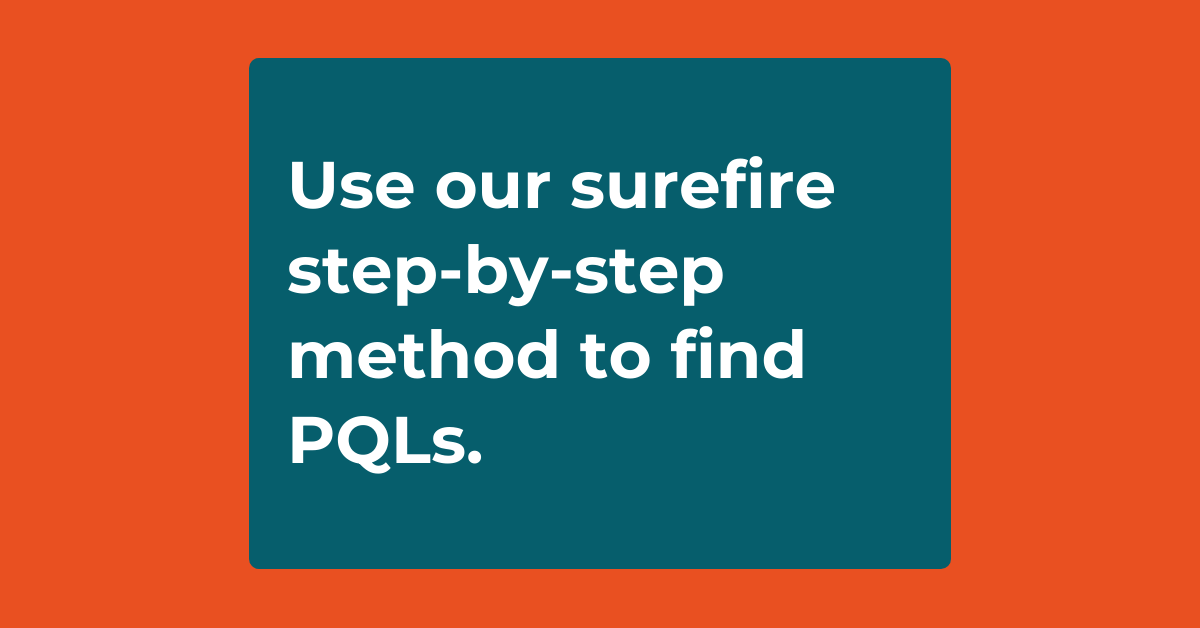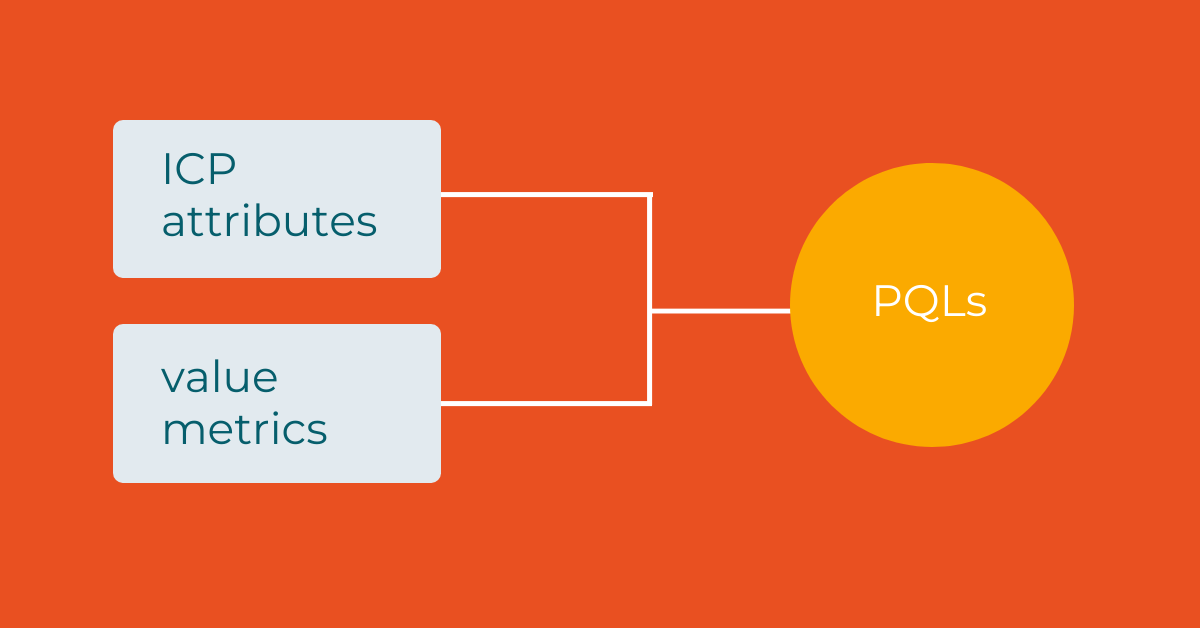How to find product qualified leads

For companies with a large volume of free users or aggressive land-and-expand strategies, it’s important to identify the subset of users who are indicating a propensity to spend money, so marketing and sales can target them to drive conversion or expansion. These users are Product Qualified Leads (PQLs). Finding them is key to product-led growth.
High-level inputs into PQLs and a common mistake
The high-level inputs that should help teams identify PQLs are:
- Attributes of the ideal customer profile (e.g. company segment, employee size)
- Value metrics
 A value metric is a quantifiable way to capture the value that your product or service delivers to your customers (from their perspective, not yours). Value metrics are more likely than other metrics to be true indicators of propensity to spend.
A value metric is a quantifiable way to capture the value that your product or service delivers to your customers (from their perspective, not yours). Value metrics are more likely than other metrics to be true indicators of propensity to spend.
We commonly see teams rushing to identify PQLs without rigorously identifying real value metrics. This rush is a mistake. It results in identifying incorrect PQLs and leaving great PQLs on the cutting room floor.
The problem is one of noise—there are thousands of product usage metrics. Which ones are the true and real indicators of conversion?
We help our customers identify these metrics by drawing upon our experience at Dropbox.
Here’s a methodology to help you in your PQL journey.
How to find your value metrics
Value metric examples
A few examples of what’s probably NOT a value metric:
- Active users: It’s not a value metric because it doesn’t capture any value being delivered to the end user. Users are active for some other purpose, not just to be active.
- Session duration: This is the time users are actively or inactively spending in your experience. This too is not a value metric since it doesn’t capture the user’s intention in spending time within your product.
A few examples of what probably IS a value metric:
- Documents created: If you’re a document authoring and sharing service, this is a great value metric because it captures why users value your product.
- Quota used: If you’re a storage or compute provider, quota usage is a strong value metric from the end user’s perspective.
- Growth in active users: This can be an indirect value metric becuase it signals usefulness.
Two steps to identify your value metrics
A cross-functional team comprising product management, growth, marketing, sales, demand generation, and product analytics should be given the mission to collectively find value metrics.
The process of finding value metrics is simple:
- Come up with a big list of hypotheses about the value of your product
- Validate hypotheses and get to value metrics
Refresh the entire process once a quarter, especially if you’re a fast growing and dynamic company that’s adding new product features and capabilities.
Step 1: Come up with the big list of value hypotheses
It’s essential at this stage to think of 20+ hypotheses and not over-restrict up front. Often, we find teams trying to discuss their way to the “top” one to three hypotheses. This scarcity mindset is biased and often results in true value indicators being left out. Just remember, step two is to reduce the list, but scientifically. So give yourself permission to think broadly.
Start with one simple example to help the v-team get oriented. Here’s one:
A customer isn’t buying a drill, they’re buying a hole. They’re not buying a hole, they’re buying a picture hanging on the wall. They’re not buying a picture on the wall, they’re buying their favorite memory with their family. That’s the difference between product features and value.
We like these three techniques for value hypothesis generation.
The why question
Ask why your users use your product. For each answer, ask why again. And then again. Usually by the third why, you have true value identified.
An example:
- Why do our users use our product? To create documents.
- Why do these users create documents? To communicate ideas with others.
- Why do they communicate ideas with others? To make collaborative decisions.
From this exercise, we can create three distinct value metric hypotheses (with varying potential signal strength):
- Documents created
- Documents shared
- Shared documents viewed/commented/edited by others
The money questions
In B2B products, often the end users are not the people writing checks. That’s why understanding value from the buyer’s perspective is as important as the end user. The first technique got us the end user perspective. This question helps us get to value for the buyer.
So ask these two questions:
- How do your customers make money by paying you money? If you’re exploring free customers, modify the question to how could your customers make money by paying you money?
- How do your customers save money by paying you money? Same mod for free customers.
An example (from Mailchimp):
- How do your customers make money by paying you money? Our customers drive their end users’ engagement and increase their LTV through marketing campaigns from our product.
- How do your customers save money by paying you money? Without our automated marketing campaign sequences, our customers will need to hire X more marketers to manually manage and orchestrate campaigns, which will cost them Y dollars.
Step 2: Validate hypotheses to come up with the small list
Now that we have a list of 10-30 hypotheses, it’s time to validate them.
Let’s say we have a hypothesis that users who convert share many files compared to users who don’t convert.
- Segment the user population with the “desirable” group, i.e. users that have converted within a time period (let’s say 3 months).
- Figure out the average number of files shared by these users in a given time period. It’s also important to calculate the variance (to assess if the average is a good gauge).
- Do the same calculations for the group that hasn’t converted.
- Compare the averages and variances of the two groups to understand if there’s a statistically significant difference between the two groups.
- If we see that, on average, users who converted shared 3x more files than users who didn’t, that’s an indication that our hypothesis is valid.
Rinse and repeat for each hypothesis. This should rule out many hypotheses. We often hear that teams find this process insightful because their assumptions get challenged and their understanding of what drives revenue evolves.
Use a lookalike model to find PQLs
Once we know the real value metrics, a good lookalike model can identify PQLs.
Intuitively, the model finds unconverted or unexpanded customers that look most like converted or expanded customers based on descriptive attributes (such as title, industry, and segment) and value metrics. If an unconverted customer is identical to converted customers in every way, they get the highest score, and vice versa.
The output of this model is not two buckets (PQLs or not PQLs). It’s a score. Teams can decide cutoff points that make sense for them.
A good model shouldn’t only provide the score, but also detailed information about why a high-scoring lead is getting a high score and which users within that account are the most interesting. This enables marketing and sales teams to target not only the right PQLs but also the right users within these, and to use the right messaging / next best action.
Shameless plug
At Falkon, we offer this entire solution and recommend next best actions on how to push these PQLs through the funnel. If you’re interested in learning more, reach out.
Want to see the Falkon PLG engine?
